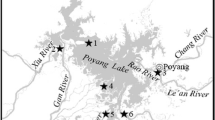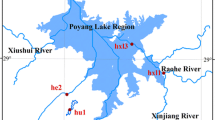Abstract
The Chishui River is the last undammed tributary of the upper Yangtze River, extends cross Sichuan, Yunnan and Guizhou provinces, and it is the significant water source of Maotai liquor, Southwest of China. We investigated microbial community of the Chishui River in the Maotai town section, because of deep relationship between the water and the most famous Chinese liquor, Maotai liquor. In this study, diversities of bacteria and archaea of four seasons were analyzed in two different sampling sites using a barcoded 16S rRNA gene-pyrosequencing approach. The results show that the predominant community among all bacteria is Proteobacteria (70.16–94.29 %), of which Gamma-proteobacteria made up the largest portion. Bacterial community structure in spring and autumn tended to group together, and the operational taxonomic units of bacteria peaked in summer. The quantitative PCR (q-PCR) results revealed significantly higher number of gene copies in the downstream than that in the upstream, and were slightly higher in summer and spring than other seasons. Archaeal community structures had no obvious regular pattern, and species richness was higher in downstream in all seasons. Euryarchaeota and Thaumarchaeota were the dominant groups in archaeal populations, and abundant ammonia-oxidizing archaea was detected. The study significantly improved our understanding of microbial community in Maotai section of the Chishui River, where the unique and world-famous Maotai liquor is produced.
Similar content being viewed by others
References
Alves RJ, Wanek W, Zappe A, Richter A, Svenning MM, Schleper C, Urich T (2013) Nitrification rates in Arctic soils are associated with functionally distinct populations of ammonia-oxidizing archaea. ISME J 7:1620–1631
Bizic-Ionescu M, Zeder M, Ionescu D, Orlic S, Fuchs BM, Grossart HP, Amann R (2015) Comparison of bacterial communities on limnic versus coastal marine particles reveals profound differences in colonization. Environ Microbiol 17:3500–3514
Böckelmann U, Manz W, Neu TR, Szewzyk U (2000) Characterization of the microbial community of lotic organic aggregates (‘river snow’) in the Elbe River of Germany by cultivation and molecular methods. FEMS Microbiol Ecol 33:157–170
Brablcova L, Buriankova I, Badurova P, Chaudhary PP, Rulik M (2015) Methanogenic archaea diversity in hyporheic sediments of a small lowland stream. Anaerobe 32:24–31
Buriankova I, Brablcova L, Mach V, Hyblova A, Badurova P, Cupalova J et al (2012) Methanogens and methanotrophs distribution in the hyporheic sediments of a small lowland stream. Fundam Appl Limnol 181:87–102
Caffrey JM, Bano N, Kalanetra K, Hollibaugh JT (2007) Ammonia oxidation and ammonia-oxidizing bacteria and archaea from estuaries with differing histories of hypoxia. ISME J 1:660–662
Chan OC, Claus P, Casper P, Ulrich A, Lueders T, Conrad R (2005) Vertical distribution of structure and function of the methanogenic archaeal community in Lake Dagow sediment. Environ Microbiol 7:1139–1149
Chen L, Wang LY, Liu SJ, Hu JY, He Y, Zhou HW, Zhang XH (2013) Profiling of microbial community during in situ remediation of volatile sulfide compounds in river sediment with nitrate by high throughput sequencing. Int Biodeterior Biodegrad 85:429–437
Crump BC, Hobbie JE (2005) Synchrony and seasonality in bacterioplankton communities of two temperate rivers. Limnol Oceanogr 50:1718–1729
Feng Q, Gao Y, Nogi Y, Tan X, Han L, Zhang Y, Lv J (2015) Flavobacterium maotaiense sp. nov., isolated from freshwater. Int J Syst Evol Microbiol 65:171–176
Feng Q, Han L, Yuan X, Tan X, Gao Y, Lv J (2015) Flavobacterium procerum sp. nov., isolated from freshwater. Int J Syst Evol Microbiol 65:2702–2708
Feng XM, Tan X, Jia L, Long PP, Han L, Lv J (2015) Flavobacterium buctense sp. nov., isolated from freshwater. Arch Microbiol 197:1109–1115
Francis CA, Roberts KJ, Beman JM, Santoro AE, Oakley BB (2005) Ubiquity and diversity of ammonia-oxidizing archaea in water columns and sediments of the ocean. Proc Natl Acad Sci USA 102:14683–14688
Ganzert L, Jurgens G, Munster U, Wagner D (2007) Methanogenic communities in permafrost-affected soils of the Laptev Sea coast, Siberian Arctic, characterized by 16S rRNA gene fingerprints. FEMS Microbiol Ecol 59:476–488
Garcia JL (1990) Taxonomy and ecology of methanogens. FEMS Microbiol Rev 87:297–308
Guo J, Peng Y, Ni BJ, Han X, Fan L, Yuan Z (2015) Dissecting microbial community structure and methane-producing pathways of a full-scale anaerobic reactor digesting activated sludge from wastewater treatment by metagenomic sequencing. Microb Cell Fact 14:1–11
Hahn MW, Kasalicky V, Jezbera J, Brandt U, Jezberova J, Simek K (2010) Limnohabitans curvus gen. nov., sp. nov., a planktonic bacterium isolated from a freshwater lake. Int J Syst Evol Microbiol 60:1358–1365
Hahn MW, Kasalicky V, Jezbera J, Brandt U, Simek K (2010) Limnohabitans australis sp. nov., isolated from a freshwater pond, and emended description of the genus Limnohabitans. Int J Syst Evol Microbiol 60:2946–2950
Hou J, Song C, Cao X, Zhou Y (2013) Shifts between ammonia-oxidizing bacteria and archaea in relation to nitrification potential across trophic gradients in two large Chinese lakes (Lake Taihu and Lake Chaohu). Water Res 47:2285–2296
Hullar MA, Kaplan LA, Stahl DA (2006) Recurring seasonal dynamics of microbial communities in stream habitats. Appl Environ Microbiol 72:713–722
Jordaan K, Bezuidenhout CC (2015) Bacterial community composition of an urban river in the North West Province, South Africa, in relation to physico-chemical water quality. Environ Sci Pollut Res 23:5868–5880
Kasalicky V, Jezbera J, Simek K, Hahn MW (2010) Limnohabitans planktonicus sp. nov. and Limnohabitans parvus sp. nov., planktonic betaproteobacteria isolated from a freshwater reservoir, and emended description of the genus Limnohabitans. Int J Syst Evol Microbiol 60:2710–2714
Konneke M, Bernhard AE, de la Torre JR, Walker CB, Waterbury JB, Stahl DA (2005) Isolation of an autotrophic ammonia-oxidizing marine archaeon. Nature 437:543–546
Methe BA, Hiorns WD, Zehr JP (1998) Contrasts between marine and freshwater bacterial community composition: analyses of communities in Lake George and six other Adirondack lakes. Limnol Oceanogr 43:368–374
Qiu L, Zhai HJ (2014) An ecological compensation mechanism of Chishui River water resources protection and research. Appl Mech Mater 685:463–467
Santoro AE, Francis CA, de Sieyes NR, Boehm AB (2008) Shifts in the relative abundance of ammonia-oxidizing Bacteria and Archaea across physicochemical gradients in a subterranean estuary. Environ Microbiol 10:1068–1079
Schultz GE Jr, Kovatch JJ, Anneken EM (2013) Bacterial diversity in a large, temperate, heavily modified river, as determined by pyrosequencing. Aquat Microb Ecol 70:169–179
Sekiguchi H, Watanabe M, Nakahara T, Xu B, Uchiyama H (2002) Succession of bacterial community structure along the Changjiang River determined by denaturing gradient gel electrophoresis and clone library analysis. Appl Environ Microbiol 68:5142–5150
Staley C, Gould TJ, Wang P, Jane Phillips, Cotner JB, Sadowsky MJ (2015) Species sorting and seasonal dynamics primarily shape bacterial communities in the upper Mississippi River. Sci Total Environ 505:435–445
Staley C, Unno T, Gould TJ, Jarvis B, Phillips J, Cotner JB, Sadowsky MJ (2013) Application of Illumina next-generation sequencing to characterize the bacterial community of the upper Mississippi River. J Appl Microbiol 115:1147–1158
Stieglmeier M, Klingl A, Alves RJ, Rittmann SK, Melcher M, Leisch N, Schleper C (2014) Nitrososphaera viennensis gen. nov., sp. nov., an aerobic and mesophilic, ammonia-oxidizing archaeon from soil and a member of the archaeal phylum Thaumarchaeota. Int J Syst Evol Microbiol 64:2738–2752
Song ZQ, Wang FP, Zhi XY, Chen JQ, Zhou EM, Liang F, Xiao X, Tang SK, Jiang HC, Zhang CL, Dong H, Li WJ (2013) Bacterial and archaeal diversities in Yunnan and Tibetan hot springs, China. Environ Microbiol 15:1160–1175
Tan X, Zhang RG, Meng TY, Liang HZ, Lv J (2014) Taibaiella chishuiensis sp. nov., isolated from freshwater. Int J Syst Evol Microbiol 64:1795–1801
Wang J, Liu F, Zhang X, Cao WX, Liu HZ, Gao X (2014) Reproductive biology of Chinese minnow Hemiculterella sauvagei Warpachowski, 1888 in the Chishui River, China. J Appl Ichthyol 30:314–321
Wu D, Huang Z, Yang K, Graham D, Xie B (2015) Relationships between antibiotics and antibiotic resistance gene levels in municipal solid waste leachates in Shanghai, China. Environ Sci Technol 49:4122–4128
Yuan X, Nogi Y, Tan X, Zhang RG, Lv J (2014) Arenimonas maotaiensis sp. nov., isolated from fresh water. Int J Syst Evol Microbiol 64:3994–4000
Zhang LM, Hu HW, Shen JP, He JZ (2012) Ammonia-oxidizing archaea have more important role than ammonia-oxidizing bacteria in ammonia oxidation of strongly acidic soils. ISME J 6:1032–1045
Zhang RG, Tan X, Liang Y, Meng TY, Liang HZ, Lv J (2014) Description of Chishuiella changwenlii gen. nov., sp. nov., isolated from freshwater, and transfer of Wautersiella falsenii to the genus Empedobacter as Empedobacter falsenii comb. nov. Int J Syst Evol Microbiol 64:2723–2728
Acknowledgments
We thank L. Q. Liang and Z. K. Zhang for their help with sample collection.
Author information
Authors and Affiliations
Corresponding author
Ethics declarations
Conflict of Interest
The authors declare that there is no conflict of interest.
Electronic Supplementary Material
Below is the link to the electronic supplementary material.
Rights and permissions
About this article
Cite this article
Feng, Q., Han, L., Tan, X. et al. Bacterial and Archaeal Diversities in Maotai Section of the Chishui River, China. Curr Microbiol 73, 924–929 (2016). https://doi.org/10.1007/s00284-016-1142-5
Received:
Accepted:
Published:
Issue Date:
DOI: https://doi.org/10.1007/s00284-016-1142-5




